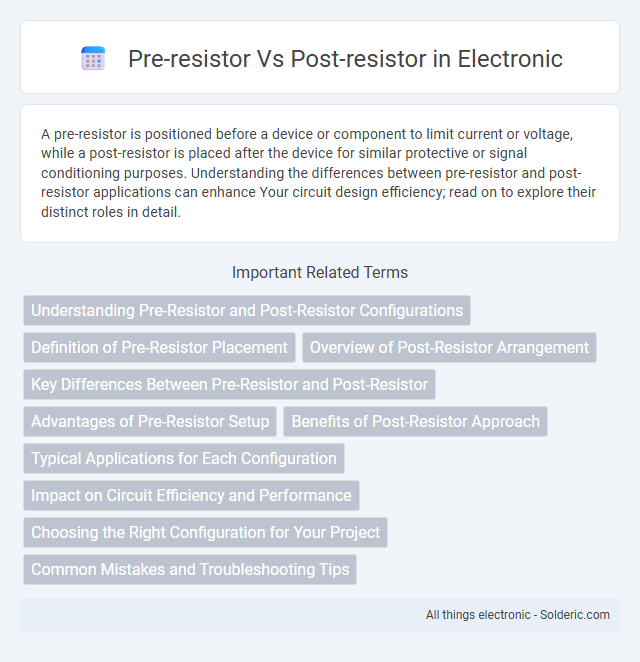A pre-resistor is positioned before a device or component to limit current or voltage, while a post-resistor is placed after the device for similar protective or signal conditioning purposes. Understanding the differences between pre-resistor and post-resistor applications can enhance Your circuit design efficiency; read on to explore their distinct roles in detail.
Comparison Table
| Aspect | Pre-Resistor | Post-Resistor |
|---|---|---|
| Definition | Resistor placed before the load or signal component | Resistor placed after the load or signal component |
| Signal Impact | Reduces input current/voltage to the load, protecting it | Limits current/voltage after passing the load; less impact on input |
| Noise Reduction | Helps reduce noise entering the load | Less effective in noise filtering |
| Voltage Drop | Causes voltage drop before the load | Voltage drop occurs after the load |
| Use Cases | Input signal conditioning, protection circuits | Output current limiting, feedback stabilization |
| Common Applications | Analog inputs, sensor circuits | LED current limiting, output stage circuits |
Understanding Pre-Resistor and Post-Resistor Configurations
Pre-resistor configurations place the resistor before the primary component, controlling current flow and protecting circuits by limiting inrush current early in the path. Post-resistor setups locate the resistor after the main component, influencing voltage drop and dissipating excess energy to safeguard downstream elements. Understanding these configurations helps you optimize circuit performance and component longevity based on specific electrical requirements.
Definition of Pre-Resistor Placement
Pre-resistor placement refers to positioning a resistor before the main load or component in an electrical circuit to regulate current flow and protect sensitive parts. This setup enables precise control of voltage and current entering the device, improving circuit stability and performance. Understanding pre-resistor placement helps you design safer and more efficient electronics by minimizing potential damage from electrical surges.
Overview of Post-Resistor Arrangement
Post-resistor arrangement places the resistor after the load in an electrical circuit, impacting voltage drop and power dissipation downstream. This configuration offers improved current regulation and better protection for sensitive components by limiting current flow after passing through the load. It is commonly used in applications requiring precise control of current and voltage stability in series circuit designs.
Key Differences Between Pre-Resistor and Post-Resistor
Pre-resistors are placed before a circuit component to limit initial current flow, protecting sensitive elements from voltage spikes, while post-resistors are positioned after the component to control current and voltage downstream, aiding in signal conditioning or load balancing. The pre-resistor primarily serves as a protective device during power surges, whereas the post-resistor influences the output characteristics and stability of the circuit. Key differences include their placement relative to the component and their dominant role in either protection (pre-resistor) or performance tuning (post-resistor).
Advantages of Pre-Resistor Setup
A pre-resistor setup offers improved voltage regulation by placing the resistor before the load, reducing voltage fluctuations more effectively. This configuration enhances circuit stability and protects sensitive components from current surges. Your system benefits from increased efficiency and prolonged component lifespan due to better current control in a pre-resistor arrangement.
Benefits of Post-Resistor Approach
The post-resistor approach enhances signal integrity by reducing noise and preventing voltage spikes after the main circuit components. It minimizes power loss and improves thermal management, leading to more reliable and efficient operation under varying loads. Utilizing a post-resistor configuration can extend component lifespan and optimize Your circuit's overall performance.
Typical Applications for Each Configuration
Pre-resistor configurations are typically used in LED circuits to limit current before entering the LED, ensuring stable operation and preventing damage in devices like indicator lights and simple lighting arrays. Post-resistor setups often appear in sensor circuits and voltage dividers where resistors stabilize voltage after signal transmission, optimizing accuracy in measurement devices and communication systems. The choice between pre- and post-resistor placement depends on the desired control over current flow and voltage stability in specific electronic applications.
Impact on Circuit Efficiency and Performance
Pre-resistors directly influence circuit efficiency by limiting current before it reaches sensitive components, reducing power loss and heat dissipation. Post-resistors affect performance by stabilizing voltage levels after key elements, aiding in signal integrity and noise reduction. Your choice between pre- and post-resistors determines power management and overall circuit reliability.
Choosing the Right Configuration for Your Project
Choosing between pre-resistor and post-resistor configurations depends on factors like signal integrity and power dissipation in your project. Pre-resistor setups are ideal for protecting components by limiting current before it reaches sensitive parts, while post-resistor arrangements are effective for stabilizing voltage levels after the load. Assess your circuit's requirements for noise reduction and component safety to determine the optimal resistor placement.
Common Mistakes and Troubleshooting Tips
Pre-resistor and post-resistor configurations are often confused, leading to improper circuit performance or damage. A common mistake is placing a resistor post-load when the design requires pre-resistor current limiting, causing voltage drops that impair device operation. To troubleshoot, verify resistor placement with the circuit schematic, measure voltage levels at key points, and replace resistors with correct values to ensure optimal protection and functionality.
pre-resistor vs post-resistor Infographic

 solderic.com
solderic.com